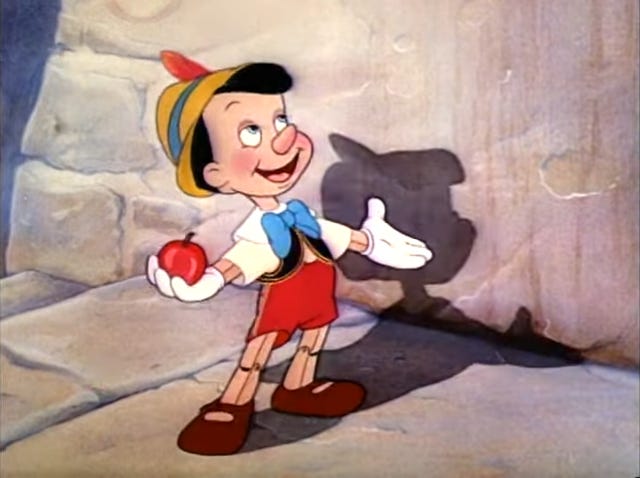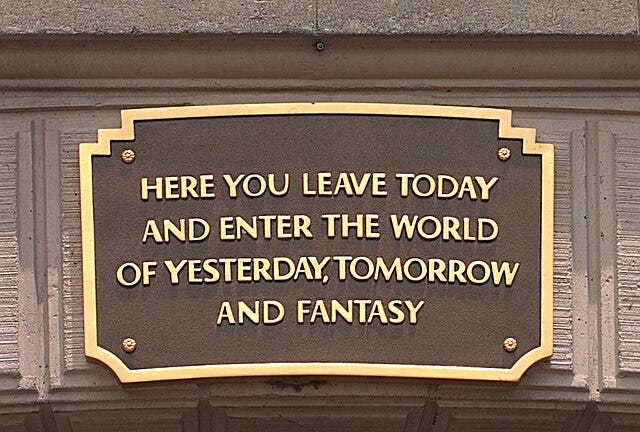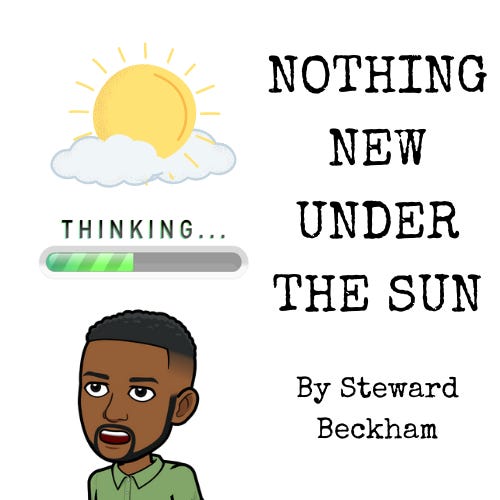When America Wished Upon A Star
And how successor generations mistook a dream for a destination.
Deep in the dreary days of the Great Depression, a flicker of enchantment emerged, a blue fairy floating across an animated night sky, granting a lonely craftsman’s wish: to bring a wooden puppet to life. That wish was underscored by a melody that would echo far beyond its origin.
“When You Wish Upon A Star” wasn’t just a lullaby; it became the cornerstone of America’s most powerful cultural mythmaker: the Walt Disney Company.
Today, when the song slips into a playlist, nostalgia bubbles to the surface. For some, it conjures the excitement of early Disney television specials and cross-country dreams of visiting Anaheim. For others, it evokes a childhood VHS shelf where Pinocchio nestled between The Goonies and Raiders of the Lost Ark. And for those lucky enough to see the original release, it may bring back the memory of putting on Sunday bests and pooling change for the movie palace, only to later watch their own children encounter the same story, now piped through the family television.
Even for those who find it overly sentimental or too “campy,” the song lingers. That’s the power of music — it transports us to emotional landmarks, tethering personal memory to collective myth.
Pinocchio

When Pinocchio premiered in 1940, it arrived at a moment of cultural acceleration and global uncertainty. It was the second fully animated feature film from Walt Disney Studios, following the astonishing success of Snow White and the Seven Dwarfs (1937), which had stunned audiences and critics alike with its emotional range and technical innovation. For Pinocchio, the Disney studio spared no expense in attempting to surpass that milestone.
The film cost an unprecedented $2.6 million to produce—an extraordinary budget during the final years of the Great Depression. Over 750 artists and technicians contributed to the production, creating more than two million individual drawings, utilizing over 1,500 shades of paint. Disney’s new Burbank campus, a purpose-built studio designed to industrialize the magic of animation, became the crucible for this monumental task.1 At the time, Bambi was also in development, but delays in story development pushed Pinocchio forward as the second feature, reflecting the studio’s breakneck pace and expanding ambitions.2
Based on the 1883 Italian novel The Adventures of Pinocchio by Carlo Collodi, the story offered a more morally complex and psychologically darker tone than Snow White. The Disney version introduced American audiences to a world where moral missteps were punished with visceral consequences, and redemption had to be earned through sacrifice and character.3 Technically, it was a marvel: its fluid animation, innovative effects (notably fire, smoke, water, and reflections), and use of the multiplane camera created a cinematic depth and realism rarely seen before. The iconic shot that zooms from the village bell tower down into the cobblestone streets remains one of the most celebrated single takes in early animation history.4
Yet despite critical acclaim for its craftsmanship, the film underperformed at the box office. It was seen by many as too frightening for young children, especially with scenes depicting transformation, deception, and predation. Its tone was more cautionary fable than lighthearted fairy tale. But the film’s commercial struggle wasn’t solely due to its narrative darkness. A larger, more ominous factor loomed over its release: Europe was at war, and global markets were closing. By the time Pinocchio debuted, the Nazi invasion of Poland had already taken place, and the world teetered on the brink of full-scale conflict. Major overseas territories that Disney had relied on for international revenue were no longer accessible, and domestic audiences were growing anxious.
And yet, despite its uneven reception, Pinocchio offered something else—a spark that would outlast box office numbers. Its musical centerpiece, “When You Wish Upon A Star,” emerged as a timeless anthem. It distilled the spirit of Disney into a single lullaby: equal parts hope, magic, and vulnerability. That song would travel farther than the film itself, carried by airwaves, record players, and the imaginations of Americans stepping into the most tumultuous decade of the 20th century.
War Clouds
Memory is a magnificent thing to study when observing history’s long shadow. For those who saw Pinocchio in its original release, the experience may have traveled with them into the war years ahead, lodged in their minds not just as a piece of entertainment, but as something emotionally resonant and culturally symbolic.
Even for those who didn’t see the film, they likely knew its defining song: “When You Wish Upon A Star.” Performed by Cliff Edwards, an artist with a vaudeville background who, troublingly, once performed in blackface5, the tune transcended its cinematic origins. While the film itself faltered at the box office, partly due to the closing of international markets amid escalating global conflict, the song flourished.
It was quickly re-recorded and distributed for radio audiences, as the United States inched closer to entering World War II. The melody became a pop culture beacon. It won the Academy Award for Best Original Song in 1940 and reached the Top 5 of Billboard’s Record Buying Guide. Frances Langford added it to her USO setlists as she performed for American troops overseas.6 Vera Lynn, the British singer whose voice came to define wartime hope, also adopted it. The song crossed oceans and battle lines, humming softly alongside the industrial clamor of war.
But more importantly, the thing to consider is how we carry stories into moments of struggle—how the dreams America sells us are smuggled into the trenches, the barracks, the blackout nights.
Members of the G.I. Generation entered World War II with the emerging power of American popular culture humming in their imaginations and rearview mirrors. The future had started to glow in the late 1930s, thanks to Disney’s rich Technicolor animations, increasingly frequent cinematic releases, and the debut of television at the 1939 New York World’s Fair. Technologies like automatic transmissions7, microwaves8, and synthetic materials like plastic9 were beginning to reshape the contours of daily life, even if many were still being developed for military or industrial purposes.
The war interrupted that promise. It cut through a generation just starting to rise from the dust of the Depression, a generation that was finally beginning to believe in the idea of “tomorrow.” And in that interruption, “When You Wish Upon A Star” became more than a lullaby. It became a hymn. A quiet national prayer for peace and prosperity—sung in the shadow of global violence.
Musicologist Sheila Whiteley has written about how popular songs during wartime often adopted fairy tale themes to soften the blow of national trauma. Songs became spells, and verses became a kind of lyrical armor. Though Whiteley doesn’t focus on Disney, the logic still fits. Disney wasn’t just echoing fairy tales—it was reanimating them, wrapping myth in melody, turning narrative into music, and feeding it back into the public psyche. It gave Americans, both young and old, a tune to hum as the world around them grew darker.10
War Clouds Disperse

The war ended. Those who returned came home to a new America, one on the cusp of global dominance and a consumer revolution. The Disney Company, having played its part in wartime propaganda and public morale, pivoted toward rebuilding. In 1950, Cinderella revived Disney’s feature-length success. And in 1945, Pinocchio was re-released, this time to warm reception from a generation that now saw the film as a parable about risk, innocence, and the wages of disobedience.
Over the next few decades, Pinocchio would be re-released regularly: 1954, 1962, 1971, 1978. It became embedded in America’s cultural rhythm.11 Even before home video, its themes and characters returned through anthology TV shows, comic books, and educational shorts featuring Jiminy Cricket.
The song, too, evolved. From wartime balm to company theme, “When You Wish Upon A Star” became Disney’s signature — a kind of moral overture before the magic begins. But the meaning shifted. What once accompanied memories of sacrifice and collective struggle became a jingle of consumption — the background music of a growing empire selling magic on demand.
That’s the strange truth of cultural memory: one generation survives catastrophe, and the next inherits the myth. For the children of the 1950s and '60s, Disney wasn’t a rare marvel — it was televised, commodified, and within reach. The G.I. Generation had hummed “When You Wish Upon A Star” while huddled near radios and bunkers. Their children heard it from the comfort of suburban living rooms.
This isn’t to romanticize the past. The postwar era was still steeped in exclusion, segregation, and inequality. But it was also cohesive in a way that’s hard to imagine today — a national project, with a shared media landscape and an emerging middle class that trusted in the future. Disney, for better or worse, was the dream machine humming in the background.
So what happens when the dream is no longer tethered to sacrifice? When the story is no longer about surviving the storm but indulging in the weather?
In the second half of this piece, I trace how Disney’s darkest cautionary tale—Pleasure Island—became a real-life adult playground. What does it mean when the warning becomes the brand?
Unlock the full story by becoming a paid subscriber.
Pleasure Island
Keep reading with a 7-day free trial
Subscribe to Nothing New Under the Sun to keep reading this post and get 7 days of free access to the full post archives.







